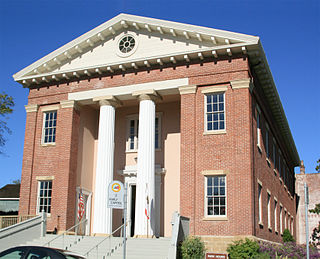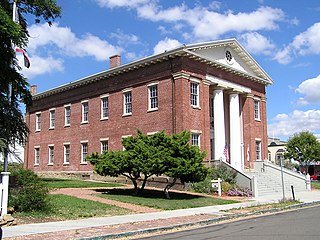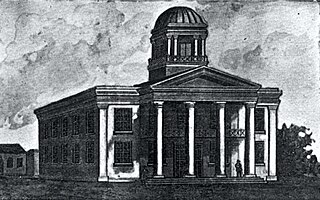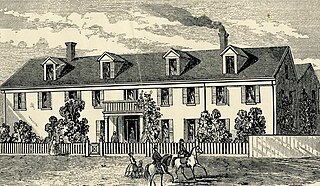
Benicia is a waterside city in Solano County, California, located in the North Bay region of the San Francisco Bay Area. It served as the capital of California for nearly thirteen months from 1853 to 1854. The population was 26,997 at the 2010 United States Census. The city is located along the north bank of the Carquinez Strait. Benicia is just east of Vallejo and across the strait from Martinez.

The Native Sons of the Golden West (NSGW) is a fraternal service organization founded in the U.S. state of California in 1875, dedicated to historic preservation and documentation of the state's historic structures and places, the placement of historic plaques, and other charitable functions in California. In 1890 the organization placed California's first marker honoring the discovery of gold, which gave rise to the state nickname, "The Golden State". U.S. President Richard M. Nixon and Chief Justice Earl Warren served terms as presidents of the NSGW.

Benicia Capitol State Historic Park is a state park in Benicia, California, United States. The park is dedicated to California's third capitol building, where the California State Legislature convened from February 3, 1853, to February 24, 1854, when they voted to move the state capital to Sacramento. It is the only pre-Sacramento capitol that remains. The park includes the Fischer-Hanlon House, an early Benicia building that was moved to the property and converted into a home in 1858, after the legislature departed. Benicia Capitol State Historic Park just off the city's main street also includes a carriage house, workers' quarters and sculptured gardens.

The Benicia Arsenal (1851–1964) and Benicia Barracks (1852–66) were part of a large military reservation located next to Suisun Bay in Benicia, California. For over 100 years, the arsenal was the primary US Army Ordnance facility for the West Coast of the United States.

Knights Ferry is an unincorporated historic community in Stanislaus County, California, United States. Nestled in the foothills of the Sierra Nevada, it is about 30 miles (48 km) east of Modesto on the Stanislaus River. The Willms Ranch near the town was one of many filming locations for the television series Bonanza and Little House on the Prairie.

The Old West Austin Historic District is a residential community in Austin, Texas, United States. It is composed of three neighborhoods located on a plateau just west of downtown Austin: Old Enfield, Pemberton Heights, and Bryker Woods. Developed between 1886 and 1953, the three historic neighborhoods stretch from Mopac Expressway east to Lamar Boulevard, and from 13th Street north to 35th Street. It borders Clarksville Historic District and the West Line Historic District to the south.

Magoffin Home is located in El Paso, Texas. It was placed on the National Register of Historic Places in 1971. The surrounding area was declared the Magoffin Historic District on February 19, 1985. The home is now known as the Magoffin Home State Historic Site under the authority of the Texas Historical Commission.
Fischer House may refer to:

The José Serrano Adobe is a historic 1863 adobe house in Lake Forest, Orange County, California. The property is one of four historic buildings in the Heritage Hill Historic Park. It was listed on the National Register of Historic Places on May 24, 1976.
Lavers' Crossing is a former settlement in Kern County, California. It was located 1 mile (1.6 km) west-northwest of Glennville, at the current junction of White River and Jack Ranch roads.

The Old Masonic Hall, also known as Benicia Masonic Hall, is a historic building in Benicia, California. Constructed by Benicia Masonic Lodge No. 5 in summer 1850, on land donated by Alexander Riddell and with lumber donated by Benicia founder Robert Semple, it was the first purpose build Masonic Hall in California. It was occupied by the lodge October 14, 1850, and formally dedicated December 27, 1850.
The Daily Republic is a daily newspaper in the town of Fairfield, California. It is owned by McNaughton Newspapers.

The Sonoma Barracks is a two-story, wide-balconied, adobe building facing the central plaza of the City of Sonoma, California. It was built by order of Mariano Guadalupe Vallejo to house the Mexican soldiers that had been transferred from the Presidio of San Francisco in 1835. The Presidio Company and their commander, Vallejo, were also responsible for controlling the Native Americans living on the northern border of Mexican California.

The Gates of Anaheim are a series of gates in California that mark the historic entrance to Anaheim, California. Four city gates were built: North, East, South, and West. They were designated a California Historic Landmark (No.122) on March 29, 1933.

Sacramento First Courthouse also, Former California State Capitol site, is historical site in Sacramento, California. The Courthouse was also the first and second California State Capitol. The site is California Historical Landmark No. 869, registered on January 11, 1974. At the northwest corner of 7th Street and I Street, 651 I Street, Sacramento was a building that served as California's State Capitol. The first period was January 16, 1852 to May 4, 1852, and the second period was from March 1, 1854, to May 15, 1854, with the California State Legislature third and fifth sessions. The 651 I Street building was the Sacramento County courthouse. The site of former California State Capitol - Sacramento County courthouse is now the Main Sacramento County Jail built in 1989. A California Historical marker was place at the site in 2007 by California State Parks working the Sacramento Trust for Historic Preservation.

Benicia Seminary was founded by a Board of Trustees in June 1852, as the Young Ladies' Seminary of Benicia in Solano County, California in the city of Benicia, California. The Benicia Seminary site is a California Historical Landmark No. 795 listed on September 6, 1964. At is peak the Young Ladies' Seminary of Beniciain had 149 students from all over Northern California. Young Ladies' Seminary of Beniciain was the Protestant Christian Junior college of its day. This was the first of this type of school in California. Mrs. S. A. Lord was the first School Principal in 1852, in 1853 Miss J. M. Hudson became Principal. In 1854, Atkins purchased the school. The Young Ladies' Seminary of Beniciain was sold to Cyrus Mills and Susan Mills in 1865 for $5,000, by Mary Atkins. Thus Benicia Seminary became Mills College. Mills College moved to Oakland, California in July 1871 by train, students, teacher and supplies. Mills College is still a private college. Mills College was granted a charter as a college by the State of california in 1885. Mary Atkins Lynch was born July 7, 1819, in Jefferson, Ohio. Mary Atkins married John Lynch (1824–1900) in 1869. Mary Lynch died September 14, 1882, at aged 63 in Benicia, California. Mary Lynch is buried at Benicia City Cemetery.

Vallejo California State Capitol was founded on May 4, 1852, at a building in Vallejo, California in Solano County, California. The Vallejo California State Capitol site is a California Historical Landmark No. 574 listed on April 1, 1957.

First Presbyterian Church of Benicia was founded on April 15, 1849, at a building in Benicia, California in Solano County, California. The Presbyterian Church of Benicia site is a California Historical Landmark No. 175 listed on March 6, 1935. The First Presbyterian Church of Benicia was the first Protestant church founded in California with a staff pastor. The pastor was Reverend Sylvester Woodbridge Jr., who founded the church in 1849 using a school house. Woodbridge came to California in 1848. First Presbyterian Church built a building that was dedicated on March 9, 1851. Woodbridge was the pastor till 1869, when he moved to San Francisco. The Presbyterian California Gold Rush church ended in 1875. The Church became a One-room school and most the members moved to the First Congregational Church of Benicia founded in 1865. Later the church-school building became an Episcopal Church. The Episcopal Church soon built a larger church. The 1851 church was remove and the land became Benicia City Park.

Saint Paul's Episcopal Church of Benicia is historical church Building built in 1859 in Benicia, California in Solano County, California. The Saint Paul's Episcopal Church is a California Historical Landmark No. 862 listed on July 20, 1973. Saint Paul's Episcopal Church was designed Lt. Julian McAllister and built by shipwrights of the Pacific Mail Steamship Company. Saint Paul's Episcopal Church is built in the early California Gothic ecclesiastical architecture. The church as dedicated 0n February 12, 1860, 163 years ago, by the church's first pastor Rev. William Ingraham and is still open. The church was founded on September 24, 1854 169 years ago, by Major F. D. Townsend, with the US Army in the Benicia Sate Capital Building.

Walters Ranch Hop Kiln is historical site of buildings built in 1905, in Sonoma, California in Sonoma County, California. The Walters Ranch Hop Kiln is a California Historical Landmark No. 627 listed on January 13, 1958. The Walters Ranch Hop Kiln was built by Italian stonemason, Angelo "'Skinny" Soldini. Sol Walters purchased 380 acres of the Rancho Sotoyome, a 1853 Mexican land grant to Josefa Fitch. The Walters Ranch Hop Kiln is composed of three stone kilns for drying hops for 20 hours a patch. Hops are used in beer making breweries. In addition to the kilns, the site as a wooden building for cooling the hops and a two-story press for baling the hops for shipment. The Walters Ranch Hop Kilns was one of early and large operation in the Northern California region.



















